Finding an affordable place to live in the United States can be challenging due to the vast differences in the cost of living across various regions. According to the Council for Community and Economic Research (C2ER), the after-tax cost for a professional/managerial standard of living can range from more than twice the national average in Manhattan, New York, to more than 20% below the national average in Decatur, Illinois.
This comprehensive guide explores the factors that contribute to the affordability of cities across the US, including housing costs, utilities, transportation, and local economic conditions. By examining these factors, we can identify cities that offer a high quality of life at a lower cost.
Key Takeaways
- The cost of living varies significantly across different regions in the US.
- Some cities offer a professional/managerial standard of living at a cost below the national average.
- Factors like housing, utilities, and transportation contribute to a city’s affordability.
- Cities with strong local economies tend to have better affordability.
- Quality of life is an important consideration when evaluating affordable cities.
Understanding Cost of Living in America
To grasp the concept of cost of living in America, it’s essential to analyze the key factors that make a city affordable or unaffordable. The cost of living in different American cities is influenced by various elements, including housing costs, median household income, and overall economic conditions.
What Determines Affordability
Affordability in American cities is primarily determined by the relationship between housing costs and median household income. Housing costs, including mortgages, rents, and insurance, are nearly 30% lower than the U.S. average in many affordable cities. For instance, in Dothan, Alabama, housing costs are 33.6% below the national average.
- Housing costs represent the largest expense for most households, with the median home price nationwide being $520,771.
- Cities with housing costs significantly below the national average typically rank as the most affordable places to live.
| City | Housing Costs as % of National Average | Median Home Price |
|---|---|---|
| Dothan, AL | 66.4% | $120,000 |
| National Average | 100% | $520,771 |
The Impact of Housing Costs on Overall Affordability
Housing costs have a significant impact on the overall affordability of a city. The relationship between median household income and median home values creates an affordability ratio that determines how accessible homeownership is for residents.
Rental markets in affordable cities follow similar patterns to home prices, with average rents often 25-35% below national averages. Housing affordability directly affects residents’ ability to save for other financial goals.
How We Identified the Most Affordable Cities in US
Identifying the most affordable cities in the US required a multifaceted approach, incorporating various economic and demographic factors. Our analysis was designed to provide a comprehensive understanding of affordability across different metropolitan areas.
Our Methodology and Data Sources
Our analysis relied on data from reputable sources, including the U.S. Census Bureau and the U.S. Bureau of Labor Statistics. Metro-level data on populations, household incomes, home values, poverty rates, and other demographic information were obtained from the U.S. Census Bureau.
Additionally, metropolitan area unemployment rates were sourced from the U.S. Bureau of Labor Statistics, with data as of January 16, 2025, for the month of November 2024, representing the latest available data. This information was crucial in assessing the economic stability of various regions.
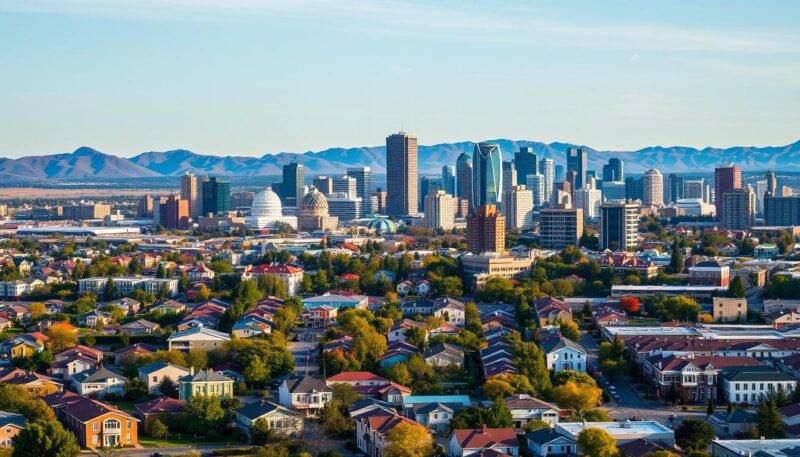
By combining these data sources, we were able to create a robust affordability profile for each city, taking into account various economic indicators.
Key Metrics Used in Our Analysis
Our analysis prioritized five key metrics to determine the affordability of each city: overall cost of living compared to the national average, median home values, median rental prices, median household income, and unemployment rates.
- We calculated cost-of-living indices for each metropolitan area by examining prices for housing, utilities, groceries, transportation, healthcare, and miscellaneous goods and services relative to national averages.
- Housing affordability was assessed through both ownership and rental metrics, comparing median home values and average rental prices against median household incomes.
- Employment opportunities were evaluated through current unemployment rates and job growth trends to ensure that affordable cities also offer reasonable prospects for financial stability and career advancement.
- Quality of life factors, including access to healthcare, education resources, public transportation, and cultural amenities, were considered as secondary metrics.
By examining these metrics, we were able to identify cities that offer a high quality of life at an affordable cost, providing a comprehensive picture of affordability across the US.
Factors That Influence Cost of Living
Understanding the factors that affect the cost of living is crucial for individuals considering relocation. The cost of living in various cities across the United States can vary significantly due to several influencing factors.
Housing Affordability and Real Estate Markets
Housing costs play a significant role in determining the overall affordability of a city. The real estate market, including housing prices and rental rates, directly impacts the cost of living. Cities with high housing costs tend to have a higher overall cost of living.
Transportation and Commuting Costs
Transportation costs, including fuel, maintenance, and public transportation fees, contribute to the overall cost of living. Cities with well-developed public transportation systems can reduce the financial burden on residents.
Utilities and Essential Services
Utilities such as electricity, water, and gas, along with essential services like internet and telecommunications, vary in cost across different regions. These expenses are a crucial part of the overall cost of living.
Food, Healthcare, and Other Daily Expenses
Food costs, healthcare expenses, and other daily expenses significantly influence the cost of living. For instance, healthcare costs in Temple, Texas, are 5.5% higher than the national average, while in Lake Charles, Louisiana, groceries, healthcare, and miscellaneous goods and services are 3% to 6% lower than the national average.
| City | Healthcare Costs | Grocery Costs | Miscellaneous Goods and Services |
|---|---|---|---|
| Temple, Texas | 5.5% above national average | Not available | Not available |
| Lake Charles, Louisiana | 3% to 6% lower than national average | 3% to 6% lower than national average | 3% to 6% lower than national average |
Factors such as local agricultural production, regional grocery market competition, and transportation distances influence food costs. Healthcare expenses vary widely due to differences in insurance premiums, out-of-pocket costs, and provider availability.
Benefits of Living in Affordable Cities
Living in affordable cities can have a significant impact on one’s financial stability and overall quality of life. As Tyler Baines, cost of living project manager and research analyst at the Center for Regional Economic Competitiveness, notes, “It is undeniable that larger metro areas like New York and Los Angeles offer better opportunities for higher paying jobs,” but jobseekers should consider more than just the size of their paycheck when deciding where to live. The benefits of affordable cities are multifaceted, ranging from financial advantages to improved quality of life.
Financial Advantages and Savings Potential
Affordable cities offer residents the opportunity to save money and improve their financial stability. Lower housing costs, reduced transportation expenses, and lower prices for goods and services all contribute to a lower cost of living. According to recent data, cities with lower costs of living often provide residents with more disposable income, enabling them to save for the future or invest in their communities.
| City | Median Home Price | Average Rent |
|---|---|---|
| Decatur, IL | $120,000 | $800 |
| Jonesboro, AR | $140,000 | $700 |
| Knoxville, TN | $170,000 | $900 |
For more information on affordable cities, you can visit Forbes for the latest reports.
Quality of Life Considerations
The quality of life in affordable cities is often enhanced by shorter commute times, less traffic congestion, and a stronger sense of community. Residents of these cities tend to enjoy a better work-life balance, with more time for leisure activities and community engagement. Some of the key benefits include:
- Shorter commute times and reduced transportation-related stress
- A more achievable work-life balance due to lower financial pressure
- Stronger community engagement and social connections
- Better access to outdoor recreation and natural amenities
- Improved cultural and entertainment options at lower price points
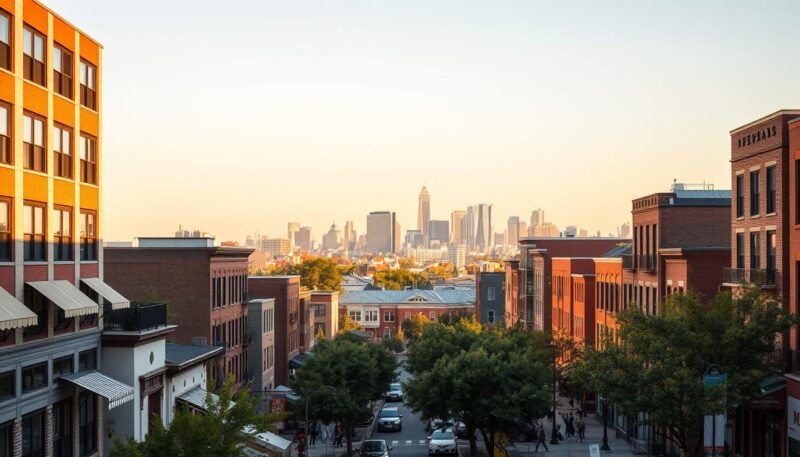
Southern Comfort: Affordable Cities in the South
The Southern United States is home to a diverse range of affordable cities that offer a high quality of life without the hefty price tag. This region is known for its warm hospitality, rich history, and a blend of urban and rural landscapes that cater to various lifestyles. In this section, we will explore four cities in the South that stand out for their affordability: Dothan, Alabama; Memphis, Tennessee; El Paso, Texas; and Oklahoma City, Oklahoma.
Dothan, Alabama
Dothan, Alabama, is a hidden gem for those seeking affordable housing. With a cost of living that is significantly lower than the national average, Dothan offers an attractive option for families and retirees alike.

The city’s median home value is around $140,000, making homeownership accessible to many. Additionally, Dothan’s economy is diverse, with major industries in healthcare, education, and manufacturing, providing a stable job market.
Memphis, Tennessee
Memphis, Tennessee, is known for its vibrant music scene and rich cultural heritage. The city also boasts a cost of living that is 16% below the national average, making it an attractive destination for those looking to relocate.

Memphis has a median household income of $43,000 and a median home value of $140,000. The city’s economy is driven by industries such as healthcare, logistics, and music, offering a range of job opportunities.
El Paso, Texas
El Paso, Texas, offers a unique blend of American and Mexican cultures, set against the backdrop of a stunning natural landscape. The city is affordable, with a cost of living that is 15% below the national average.

El Paso’s median home value is around $170,000, and the median household income is approximately $44,000. The city’s economy is driven by sectors such as the military, healthcare, and education.
Oklahoma City, Oklahoma
Oklahoma City stands out with a cost of living 16.4% below the national average, offering one of the most substantial affordability advantages among major metropolitan areas in the United States.

The city has undergone significant revitalization, with investments in the downtown area, riverfront development, and cultural institutions. Housing costs remain exceptionally affordable, with median home values of $227,300, allowing middle-income households to comfortably afford homeownership. Oklahoma City’s diverse economy includes strong sectors in energy, aviation, healthcare, and government, contributing to a healthy unemployment rate of 3.5% and providing residents with career stability.
Midwest Values: Budget-Friendly Cities in America’s Heartland
America’s heartland offers a unique blend of affordability, cultural attractions, and quality of life, with several Midwestern cities standing out as particularly budget-friendly. These cities provide residents with a high quality of life without the hefty price tag associated with many coastal areas.
Peoria, Illinois
Peoria, Illinois, is a prime example of an affordable Midwestern city, offering a cost of living that is significantly below the national average. With a median home value of $123,000, housing costs are particularly attractive to middle-income households.

Fort Wayne, Indiana
Fort Wayne, Indiana, boasts a cost of living that is 14% lower than the national average, making it an attractive option for those seeking affordability without sacrificing quality of life. The city’s median household income is $54,475, and the median home value is $134,900.

Dayton, Ohio
Dayton, Ohio, is another city in the Midwest that offers an affordable lifestyle, with a cost of living 13% below the national average. The city has a diverse economy, with major employers in healthcare, education, and technology, contributing to a median household income of $44,744.

Cedar Rapids, Iowa
Cedar Rapids, Iowa, stands out for its exceptional affordability, with a cost of living 14.8% below the US average. The city’s median household income is $61,437, and the median home value is $148,700, making homeownership relatively accessible to middle-income households.
- Cedar Rapids offers a diverse economy with major employers like Collins Aerospace, Transamerica, and Quaker Oats.
- The city’s unemployment rate is a healthy 3.5%, indicating a stable job market.
- Residents enjoy recreational opportunities along the Cedar River and cultural attractions like the Cedar Rapids Museum of Art.
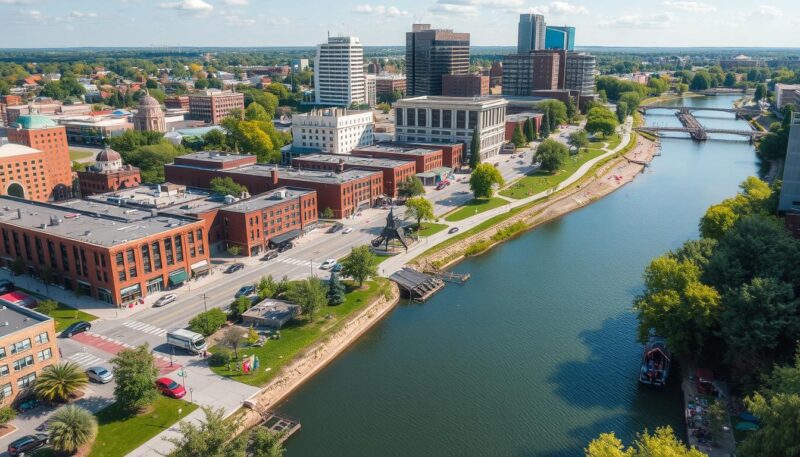
These Midwestern cities offer a compelling combination of affordability, economic stability, and quality of life, making them attractive options for individuals and families looking to relocate.
Eastern Opportunities: Affordable Cities on the East Coast
The East Coast offers a diverse range of affordable cities that balance quality of life with economic viability. From the mountains of West Virginia to the urban centers of New York, there are numerous opportunities for those looking to relocate to a more affordable area without sacrificing the benefits of city living.
Rochester, New York
Rochester, NY, is known for its affordable housing market. With a median home value significantly lower than many other major cities in the Northeast, it presents an attractive option for homebuyers.

Buffalo, New York
Buffalo, NY, offers a cost of living that is below the national average, making it an attractive option for those looking to relocate. The city’s median household income is around $43,000, and the unemployment rate is relatively low.
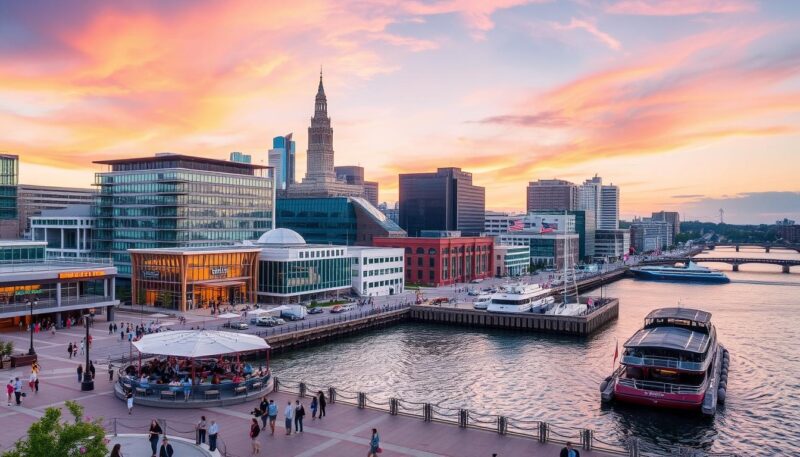
Charleston, West Virginia
Charleston, the capital of West Virginia, stands out for its exceptional affordability, with a cost of living 16.2% below the US average. The median household income is $58,902, and the median home value is $172,800, making homeownership accessible to middle-income households.
- Charleston offers exceptional affordability with a cost of living 16.2% below the national average.
- As West Virginia’s capital and largest city, Charleston provides urban amenities while maintaining the charm of smaller Appalachian communities.
- Housing costs are particularly attractive, allowing middle-income households to afford homeownership comfortably.
- The city’s picturesque setting along the Kanawha River provides natural beauty and outdoor recreation opportunities.
- Major employers include the state government, CAMC Health System, and energy companies, creating a stable job market with an unemployment rate of 4.3%.

The Most Affordable Cities in US for 2025
The most affordable cities in the US for 2025 have been identified based on a comprehensive analysis of cost of living, quality of life, and economic stability. These cities offer residents a unique blend of financial practicality and a high quality of life.
Decatur, Illinois: America’s Most Affordable City
Decatur, Illinois, stands out as one of the most affordable cities in the US. With a cost of living that is significantly below the national average, Decatur offers an attractive option for those looking to relocate.

Jonesboro, Arkansas: Low Costs with High Quality of Life
Jonesboro, Arkansas, is another city that makes the list for its affordability and high quality of life. The city’s median household income is competitive, and its unemployment rate is lower than the national average.

Knoxville, Tennessee: Southern Charm at Budget Prices
Knoxville, Tennessee, offers the charm of the South at budget-friendly prices. With a cost of living that is below the national average, Knoxville is an attractive option for families and retirees alike.
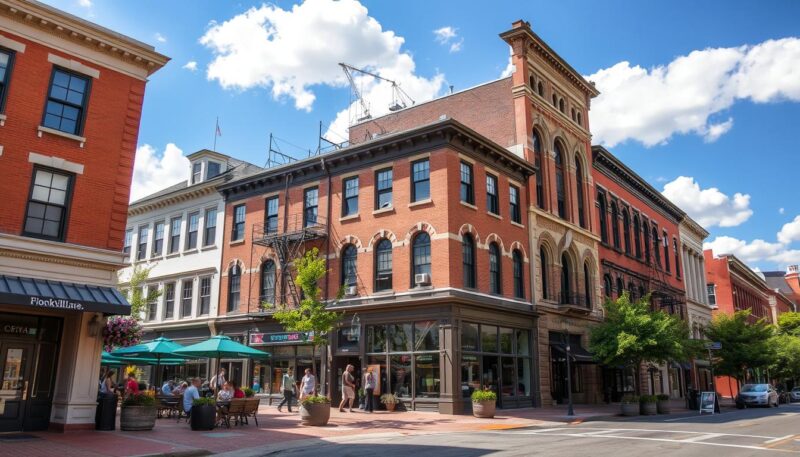
Corpus Christi, Texas: Affordable Coastal Living
Corpus Christi, Texas, is a standout for its affordable coastal living. With a cost of living 11.8% below the US average, Corpus Christi offers residents the chance to enjoy Gulf Coast beaches without the high costs associated with other coastal cities.
- Corpus Christi offers the rare combination of coastal living with a cost of living 11.8% below the national average, making it one of the most affordable beachfront cities in the United States.
- Housing costs are particularly attractive for a coastal location, with median home values of $197,100 allowing middle-income households to afford properties that would be multiples higher in price on either the Atlantic or Pacific coasts.
- The city’s economy is diversified across energy, military, education, healthcare, and tourism sectors, creating a relatively stable job market with an unemployment rate of 4.5%.
- Residents enjoy more than 250 days of sunshine annually and miles of Gulf Coast beaches, providing recreational opportunities and a vacation-like atmosphere at a fraction of the cost of other coastal destinations.
- The presence of Texas A&M University-Corpus Christi creates educational opportunities and cultural amenities, while the lack of state income tax in Texas provides additional financial benefits for residents.

Housing Costs Comparison Across Affordable Cities
When considering a move to an affordable city, understanding the nuances of housing costs is crucial. Housing expenses, whether for renting or buying, significantly impact the overall cost of living. This section compares housing costs across various affordable cities, providing insights into both home ownership costs and rental market trends.
Home Ownership Costs
Home ownership costs in affordable cities can be significantly lower than in major metropolitan areas. The median home price in cities like Decatur, Illinois, and Jonesboro, Arkansas, is substantially below the national average. For instance, the median home price in Decatur is around $120,000, compared to the national median of approximately $270,000. This difference translates into lower mortgage payments, property taxes, and insurance costs.
| City | Median Home Price | Mortgage Payment |
|---|---|---|
| Decatur, IL | $120,000 | $600 |
| Jonesboro, AR | $140,000 | $700 |
| Knoxville, TN | $170,000 | $850 |
Rental Market Analysis
Rental markets in affordable cities typically offer significant savings compared to national averages. Average rents are often 25-35% below national averages in the most affordable metropolitan areas. For example, in Peoria, Illinois, the average rental price for a 2-bedroom apartment is around $1,000, compared to the national average of approximately $1,578.
The rent-to-income ratio in these cities is also more favorable, typically falling between 15-25% of median household income. This is well below the 30% threshold considered standard for housing affordability and dramatically better than the 40-50% common in expensive coastal markets.
Rental housing stock varies across affordable cities, with some offering older, single-family homes converted to rentals, while others feature modern apartment complexes. Vacancy rates tend to be higher, giving renters more negotiating power and choice. Rental price appreciation has been more moderate in affordable cities, creating greater stability for renters planning their budgets.
Beyond Housing: Other Cost Factors to Consider
When considering a move to an affordable city, factors beyond housing costs play a significant role in determining the overall cost of living. While housing is a major expense, other costs such as utilities, transportation, and taxes can significantly impact your quality of life and overall affordability.
Tax Implications by Region
Tax implications vary significantly across different regions in the US. Some states offer more favorable tax environments than others, which can greatly affect the overall cost of living. For instance, states with lower gas taxes, like Oklahoma and Texas, often have gasoline prices 10-15% below the national average. Understanding these regional tax differences is crucial for accurately assessing the affordability of a city.
Additionally, property taxes and sales taxes also play a significant role in the overall tax burden. Cities with lower property taxes can offer significant savings for homeowners, while higher sales taxes can increase the cost of living. It’s essential to consider these factors when evaluating the affordability of a city.
Utility and Transportation Expenses
Utility costs and transportation expenses are other critical factors that influence the cost of living in affordable cities. Utilities, which include electricity, water, and gas, can vary significantly based on climate, energy sources, and infrastructure. For example, cities like Lake Charles, Louisiana, offer utilities at 32% below the national average, while others like Temple, Texas, have utility costs nearly 10% above average.
Transportation expenses are heavily influenced by city layout and commuting patterns. More compact cities or those with robust public transportation options tend to offer greater savings compared to sprawling metropolitan areas that require longer commutes. Gasoline prices also show regional variation, with cities near refineries or in states with lower gas taxes enjoying lower prices.
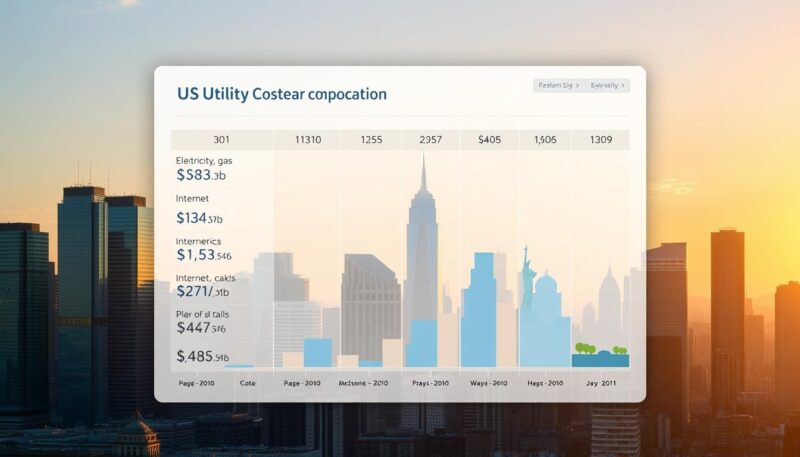
Furthermore, vehicle insurance costs vary based on state regulations, traffic density, and accident rates, creating another variable transportation expense that differs substantially between affordable cities, even within the same region. Understanding these nuances is key to making an informed decision about which city offers the best overall affordability.
Quality of Life in Affordable Cities
Affordable cities are not just about saving money; they’re about living a fulfilling life. The quality of life in these cities is influenced by various factors, including employment opportunities, education, healthcare, and community resources.

Employment Opportunities and Job Markets
Employment opportunities in affordable cities are often driven by local industries, with some cities serving as regional hubs. For instance, cities like Knoxville, Tennessee, with the presence of major research institutions like the University of Tennessee, offer a robust job market. Residents in these cities have access to a range of job opportunities, contributing to a solid local economy.
The job market in these cities is diverse, with opportunities in various sectors. The presence of universities and research centers not only provides employment but also fosters innovation and entrepreneurship. This diversity in the job market enhances the overall quality of life by providing residents with options and opportunities for career advancement.
Education, Healthcare, and Community Resources
Affordable cities offer a range of educational resources, from major research institutions to community colleges, providing accessible higher education options. For example, cities like Rochester, New York, are home to several universities and medical centers, ensuring good education and healthcare facilities.
- Public school quality can vary within cities, making neighborhood selection crucial for families.
- Healthcare access is generally good in regional hubs, though smaller cities may have limited specialist care.
- Community resources, including libraries, parks, and social services, are typically well-developed.
- Cultural institutions like museums and theaters are present, often supported by local universities.
These resources contribute significantly to the quality of life, making affordable cities attractive to families, professionals, and retirees alike. The presence of good schools, healthcare facilities, and community resources ensures that residents have access to essential services and options that enhance their living experience.
Who Should Consider Moving to These Affordable Cities
The most affordable cities in the US offer a unique blend of quality of life and financial prudence, attracting various demographics. These cities provide a range of benefits that cater to different needs and lifestyles.
Remote Workers and Digital Nomads
Remote workers and digital nomads can significantly benefit from the lower cost of living in these affordable cities. With reduced expenses on housing, utilities, and daily necessities, they can enjoy a higher quality of life without the high costs associated with major metropolitan areas. Cities like Knoxville, Tennessee, and Oklahoma City, Oklahoma, offer a great balance of affordability and amenities that support remote work, including reliable internet and community spaces.
Families and Retirees
Families and retirees are among those who can greatly benefit from moving to these affordable cities. For families, the combination of affordable housing and good public schools available in many budget-friendly cities allows them to secure appropriate housing without overextending financially. The lower cost of living enables families to live comfortably on a single income or reduce working hours, creating more time for parenting and family activities. For retirees, cities in states like Tennessee and Texas offer tax advantages, such as no income tax on retirement distributions. According to MoneyGeek, retirees may find the lack of inheritance or estate tax a reason to get a homestead of their own in Texas. Additionally, affordable cities that serve as regional medical hubs, like Knoxville and Oklahoma City, offer the best combination of quality healthcare and lower living costs.
Overall, the affordability, quality of life, and tax benefits make these cities attractive to a wide range of individuals and families.
Potential Drawbacks of the Most Affordable Cities
While affordable cities offer numerous benefits, there are also some drawbacks to consider when making a decision about relocating. The lower cost of living can be attractive, but it’s essential to examine the potential downsides to ensure that the city aligns with your needs and expectations.
Economic Challenges in Low-Cost Areas
Economic challenges are a significant consideration in affordable cities. Job opportunities may be limited, and wages can be lower compared to larger metropolitan areas. This can impact the overall quality of life, making it essential to research the local job market and economic conditions before making a decision.
Amenities and Entertainment Options
Amenities and entertainment options are another area where affordable cities may fall short. Residents may find that cultural events, dining options, and shopping experiences are more limited compared to larger cities. For instance:
- Cultural and entertainment options are typically more limited, with fewer museums, professional sports teams, and concert venues.
- Dining scenes, while improved in recent years, still offer less diversity and fewer high-end options.
- Shopping options tend to be more mainstream, with fewer specialty retailers and luxury brands available locally.
It’s crucial to weigh these limitations against the benefits of living in an affordable city. Planning an extended visit can help determine whether the city offers the lifestyle you desire. 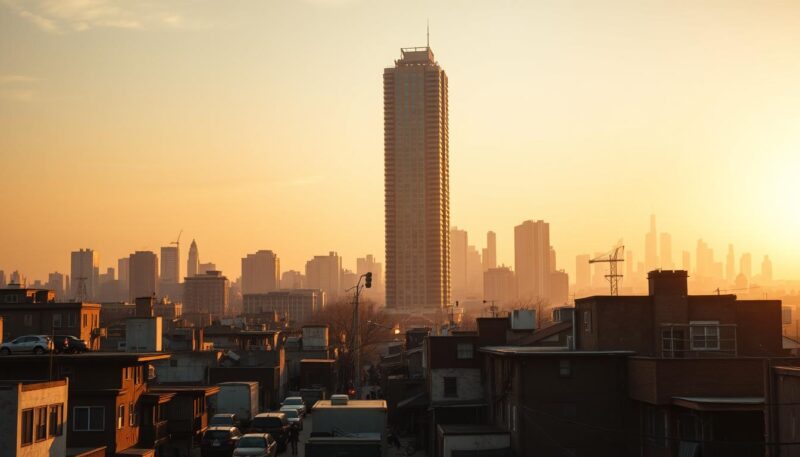
Tips for Relocating to a More Affordable City
A successful relocation to an affordable city demands thorough research and financial planning. When considering a move, it’s crucial to evaluate various factors that impact your quality of life and financial stability.
Financial Planning for Your Move
Financial planning is a critical step in relocating to a more affordable city. This involves calculating the total cost of your move, including transportation, housing deposits, and initial living expenses. It’s also essential to research the local economy, job market, and cost of living to ensure that your new location aligns with your financial goals.
Creating a budget that accounts for housing, utilities, food, and other daily expenses will help you navigate your new financial landscape. Consider consulting with a financial advisor to get personalized advice on managing your relocation.
Researching Neighborhoods and Communities
Researching neighborhoods and communities is vital to finding the right fit for your lifestyle and preferences. Start by gathering data on local safety statistics, school quality, and available amenities. Resources like GreatSchools.org can provide valuable insights into academic performance and student-teacher ratios.
- Visit potential neighborhoods at different times to gauge traffic patterns and community activity.
- Connect with local community groups through social media to gain insider perspectives on neighborhood dynamics and local events.
- Consider commute times and transportation options between your potential neighborhood and employment centers.
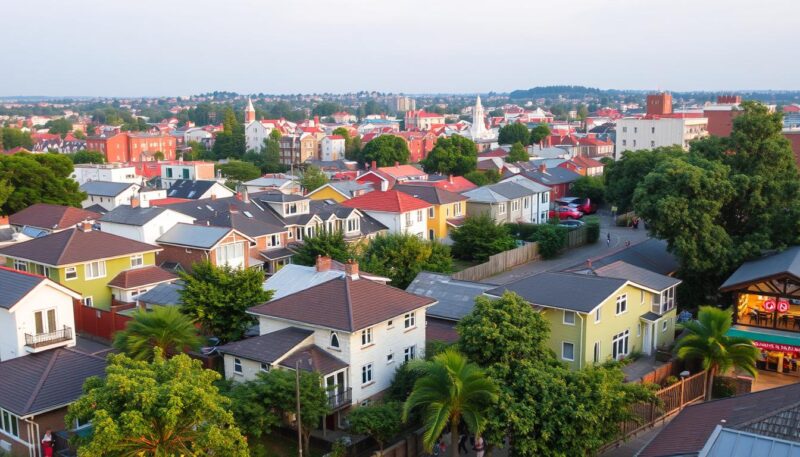
Future Outlook: Affordability Trends for 2025 and Beyond
As we look towards 2025 and beyond, the landscape of affordable cities in the US is poised for significant changes. The future of affordability will be shaped by various economic factors, demographic shifts, and urban development trends.
Economic Factors Affecting City Affordability
Economic conditions play a crucial role in determining the affordability of cities. Factors such as housing costs, job market growth, and state tax policies significantly influence the cost of living. “The affordability of a city is not just about low housing costs; it’s also about the overall economic health and opportunities available to residents,” says a housing market expert.
Smaller cities within commuting distance of growing regional hubs are emerging as the next frontier of affordability. These areas offer lower housing costs while maintaining access to the amenities and job markets of larger metropolitan areas. Midsize cities in states with favorable tax structures, such as Tennessee, Texas, and Florida, are particularly well-positioned for growth due to their affordability and the absence of state income taxes.
Up-and-Coming Affordable Cities to Watch
Several cities are gaining attention for their potential to become future affordable hubs. College towns with strong educational institutions are attracting remote workers and retirees seeking affordability combined with cultural amenities. Cities like Springfield, Missouri, and Huntsville, Alabama, are investing in downtown revitalization and quality of life improvements, making them attractive to those seeking affordability without sacrificing amenities.
Infrastructure investments, particularly in broadband connectivity and transportation, are making previously isolated affordable areas more viable for relocation. As a result, the map of potential affordable destinations is expanding beyond traditional metropolitan areas.
Conclusion: Finding Your Affordable American Dream
As the landscape of work and living continues to evolve, the most affordable cities in the US for 2025 present compelling options for those looking to relocate. The decision to move to a new city involves considering various factors, including housing costs, utilities, food, transportation, and entertainment expenses.
The most affordable cities in the US for 2025 offer significant cost savings compared to expensive coastal markets. Places like Decatur, Illinois, and Jonesboro, Arkansas, provide living costs that are 15-20% below the national average. These cities not only offer financial advantages but also a good quality of life.
Finding the right balance between cost and quality of life is essential. The American dream of homeownership is more accessible in these affordable cities, where median-income households can purchase homes for 2-3 times their annual income. Moreover, long-term financial security is achievable due to lower housing costs and everyday expenses, allowing for greater retirement savings and financial flexibility.
Key considerations for those looking to move include:
- Balancing cost with quality of life factors and employment opportunities.
- Access to amenities that matter to your lifestyle and priorities.
- The potential for long-term financial security through savings and reduced debt.
- The viability of remote work options in affordable cities.
In conclusion, the most affordable cities in the US for 2025 offer a unique blend of cost savings, quality of life, and future opportunities. By carefully considering these factors, individuals and families can find their affordable American dream, achieving a better balance between living costs and lifestyle aspirations.
FAQ
What are the key factors that determine the affordability of a city?
The affordability of a city is determined by several factors, including housing costs, transportation expenses, utility bills, food prices, and other daily expenses. The median household income and state income tax also play a significant role in determining the overall affordability of a city.
How do housing costs impact the overall affordability of a city?
Housing costs are a significant component of the overall cost of living in a city. Cities with lower housing costs, such as Oklahoma City, Oklahoma, and Decatur, Illinois, tend to be more affordable. The cost of homeownership, including mortgage payments, property taxes, and insurance, as well as rental costs, are essential considerations.
What are some benefits of living in an affordable city?
Living in an affordable city can provide numerous benefits, including lower living expenses, increased savings potential, and a higher quality of life. Affordable cities often offer a range of amenities, including job opportunities, education, healthcare, and community resources, making them attractive to families, retirees, and remote workers.
How do transportation costs vary across different cities?
Transportation costs, including fuel, maintenance, and public transportation expenses, can vary significantly across different cities. Cities with well-developed public transportation systems, such as Rochester, New York, and Charleston, West Virginia, tend to have lower transportation costs.
What are some potential drawbacks of living in an affordable city?
While affordable cities offer many benefits, there are potential drawbacks to consider, including economic challenges, limited job opportunities, and fewer amenities and entertainment options. However, many affordable cities are working to address these challenges and improve the overall quality of life for residents.
How can I research neighborhoods and communities when considering a move to an affordable city?
Researching neighborhoods and communities is crucial when considering a move to an affordable city. You can start by looking at local crime statistics, school districts, and community resources. You can also visit the city, talk to locals, and explore different neighborhoods to get a feel for the area.
What are some up-and-coming affordable cities to watch?
Some up-and-coming affordable cities to watch include cities in the Midwest, such as Peoria, Illinois, and Fort Wayne, Indiana, which offer a low cost of living and a range of job opportunities. Other cities, such as Knoxville, Tennessee, and Corpus Christi, Texas, are also becoming increasingly popular due to their affordability and quality of life.
